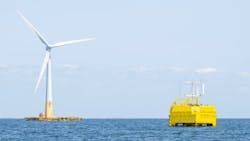Sealhyfe hydrogen platform passes initial offshore tests
Offshore staff
NANTES, France — Lhyfe has issued results from an extended trial off western France of its offshore hydrogen production pilot platform, Sealhyfe, which returned to dock last November.
The facility, equipped with a 1-MW electrolyser supplied by Plug, was designed to prove the feasibility of hydrogen production from renewable energy offshore.
Other aims included confirming the reliability of the electrolysis technology in harsh environmental conditions representative of future large-scale offshore sites; delivering operating data to help optimize production processes to be more reliable; and to test the technologies involved with a view to scaling them up to offshore locations with eventually 100 times greater capacity.
On board the Sealhyfe platform, various measurement and data collection instruments provided management and control of all the system’s parameters from September 2022 to November 2023, initially at the quayside and then at sea.
Lhyfe conducted repeated tests of the system’s responsiveness in wide-ranging configurations. These demonstrated its capability to manage the variability of wind power in specific offshore conditions.
The electrolysis system operated as part of the program, including at maximum production capacity, with the performance said to be as high as a land-based installation.
Lhyfe also tested the production system equipment in extreme conditions for platform movement management and environmental stress. These included Storm Ciaran, which hit the French Atlantic coast in October, generating waves over 10 m high and winds of more than 150 kph.
Analysis of the production system once back on land confirmed that all equipment was undamaged with the production capacity intact.
Throughout the experiment, onboard and remotely controlled measuring instruments were used to determine methods of optimizing efficiency and reliability of the safety systems, electrical architecture, automation, fluid and stock management.
The quayside benchmark testing phase also helped to de-risk the project, identifying most of the impacts specific to offshore hydrogen production. Thereafter, the site was operated remotely from Lhyfe's control center, using supervision and control tools developed by the company.
According to Lhyfe, the experiment allowed validation of software and algorithms for producing green and renewable hydrogen, and a reduction in the number of operations required in the marine environment. There were fewer than 10 maintenance operations and the system ran for 70% of the operating time.
Finally, the company worked with the French authorities to define operating rules for a green hydrogen production unit operating within an urban, industrial and port environment, and capable of operating in the open sea.
The results of this experiment are being incorporated into the HOPE project, selected by the European Commission for a €20 million grant as part of the Clean Hydrogen Partnership, along with an additional €13 million grant from the Belgian government. The consortium of nine companies, led by Lhyfe, aim to achieve commercialization of green hydrogen production offshore.
Their planned 10-MW project will be designed to produce up to 4 metric tons per day of green hydrogen at sea, exported ashore by pipeline and then compressed and delivered to clients.
01.29.2024
